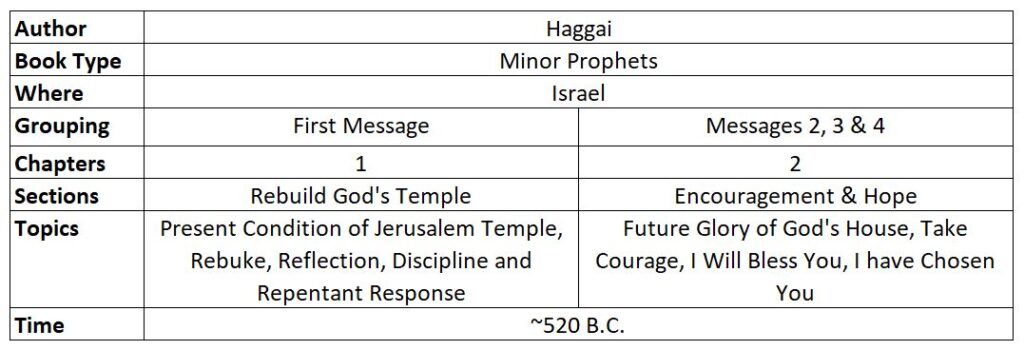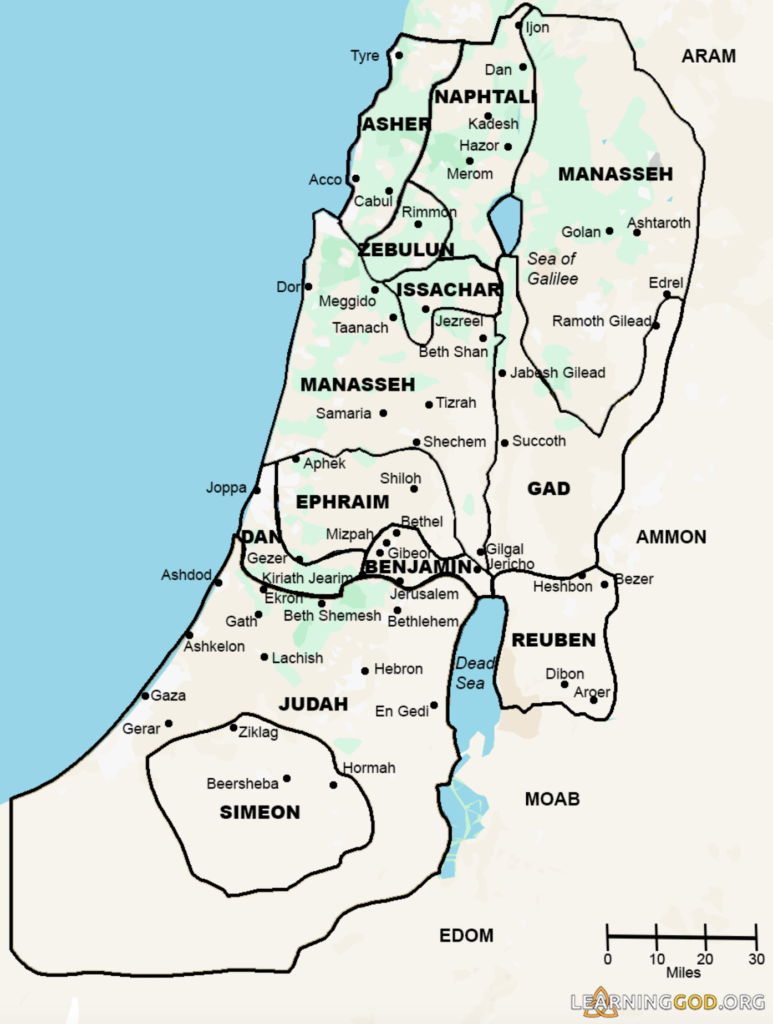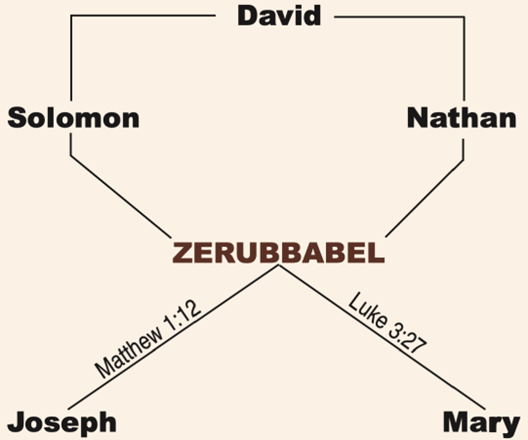Haggai
Spiritual Renewal
Summary | About | Why You Should Read it | Author | When Written | Context | Timeline | Location | Outline | Observations | Resources
Summary
The book of Haggai is one of the twelve minor prophets in the Old Testament, and it focuses on the rebuilding of the temple in Jerusalem after the Babylonian exile. Written around 520 BC, Haggai’s short but powerful message is directed at the Jewish people who had returned from exile. The key themes of the book include:
- Call to Rebuild the Temple: Haggai calls on the people to prioritize rebuilding the temple, which had been destroyed. The people were more focused on their own homes and economic struggles, but Haggai emphasizes that neglecting God’s house leads to their difficulties.
- Obedience and Prosperity: Haggai teaches that their prosperity is tied to their obedience to God. When they focus on rebuilding the temple, God promises blessings and renewal.
- God’s Presence and Encouragement: The book reassures the people that despite the challenges, God is with them. Haggai promises that the glory of the new temple will surpass the former one, pointing to a future filled with hope.
- Future Hope and Messianic Promise: Haggai’s prophecies also hint at the coming of a greater kingdom and the messianic hope, which will ultimately bring peace and God’s reign.
Overall, Haggai encourages spiritual renewal, faithfulness, and putting God’s priorities first to experience His blessings.
The following table provides a high-level look at the structure and contents of the book of Haggai.

About
Haggai is the 37th book of the Bible and the 10th of the books of the Minor Prophets of the Old Testament.

Why You Should Read It
Reading the book of Haggai offers valuable insights and lessons that are relevant today, despite its ancient context. Here are a few reasons why it might be worth reading:
- Prioritizing Spiritual Commitments
Haggai emphasizes the importance of putting God first in your life. If you find that your priorities are skewed or you’re distracted by personal pursuits at the expense of spiritual growth, Haggai is a reminder that making space for God can lead to blessings and fulfillment.
- Encouragement in Times of Discouragement
The people in Haggai’s time were disheartened by the daunting task of rebuilding the temple, and their efforts seemed insignificant. If you’re feeling overwhelmed by challenges or frustrated that your efforts aren’t yielding visible results, Haggai offers encouragement: God values faithfulness over appearances and assures us that His presence is with us even in difficult times.
- A Call to Action
If you’re struggling with complacency or procrastination, the urgency of Haggai’s message may resonate with you. The book calls you to take decisive action in your faith and reminds you of the importance of completing the work God has called you to do.
- Promises of Hope and Renewal
The book doesn’t just focus on immediate tasks but also points to a future hope. Haggai touches on the idea of God’s ultimate plan for restoration, which can be comforting when facing uncertainty or when looking for reassurance that present struggles have a purpose in the bigger picture.
- Faith and Obedience Lead to Blessing
A key message in Haggai is that obedience to God leads to divine blessing. If you’re looking to understand how faithfulness impacts your life—both spiritually and practically—Haggai offers a clear example of how trusting in God’s plans leads to His provision.
Overall, Haggai speaks to anyone looking for clarity, purpose, and motivation in their spiritual life. Its focus on putting God first, staying faithful, and working through discouragement provides a timeless message for personal reflection and growth.
Author
The author of the book of Haggai is traditionally identified as the prophet Haggai himself, though little is known about him personally. His name means “festal” or “festival,” which could suggest that he was born during one of the Jewish festivals, but this is speculative. Haggai was a contemporary of the prophet Zechariah, who also encouraged the people to rebuild the temple. Both prophets were instrumental in stirring up the people to resume the work on the temple, which had stalled.
When Written
Haggai was the first of the post-exilic prophets. He prophesied around 520 B.C.
Context
The book of Haggai was written in the context of the post-exilic period of Israel’s history, around 520 BC, during the reign of the Persian King Darius I. Here’s a deeper look into the historical and cultural context:
- The Return from Exile
In 586 BC, the Babylonians, under King Nebuchadnezzar, destroyed Jerusalem and the temple, and the Israelites were taken into exile in Babylon. After about 70 years, the Persian Empire, led by King Cyrus, conquered Babylon in 539 BC. Shortly after, Cyrus issued a decree allowing the Jewish exiles to return to their homeland and rebuild the temple in Jerusalem (as recorded in Ezra 1:1-4).
- Initial Efforts to Rebuild
Around 50,000 Jews returned under the leadership of Zerubbabel (a descendant of King David) and Joshua the high priest. They began rebuilding the temple soon after their return, laying the foundation (around 536 BC). However, opposition from local enemies, bureaucratic red tape, and general discouragement caused the work to stop for nearly 16 years. During this period, the people shifted their focus to rebuilding their own homes and lives, neglecting the temple project.
- Economic Hardship and Spiritual Apathy
The people of Judah were struggling economically. Harvests were poor, and there were ongoing difficulties in establishing a stable life after returning from exile. The people believed it wasn’t the right time to rebuild the temple due to these challenges. Their attention turned to their own prosperity, and their spiritual enthusiasm waned. Haggai’s prophecies suggest that the economic hardships they faced were linked to their neglect of God’s house (Haggai 1:6-11).
- Haggai’s Prophetic Ministry
In this context of discouragement and delay, Haggai’s prophetic ministry began in 520 BC. Haggai’s message was simple but urgent: the people needed to stop focusing solely on their own needs and prioritize the reconstruction of the temple. His message was delivered over a few months and, importantly, it received a positive response. The people, led by Zerubbabel and Joshua, resumed work on the temple.
- The Persian Influence
Judah was still under Persian rule, and while the Persians allowed the rebuilding of the temple, the Jews had no political autonomy. This meant they had to navigate their religious and cultural rebuilding under the oversight of a foreign empire. Haggai’s message includes both encouragement to the people and reassurances that God would work through these challenges to fulfill His purposes.
- Covenant Relationship and Future Hope
Haggai’s prophecies also looked beyond the immediate rebuilding project. He connected the temple’s reconstruction with broader covenant promises, including messianic hopes and the future glory of God’s kingdom. This reflects the ongoing theological belief that God was still at work, restoring His people and fulfilling the promises made to their ancestors.
Key Themes in the Context:
- Spiritual Renewal: The people had returned physically but needed to return to God spiritually.
- Restoration of Worship: The temple represented God’s presence among His people, and its rebuilding was essential for the restoration of proper worship.
- Hope Amid Discouragement: Many remembered the grandeur of Solomon’s temple and felt discouraged by the modest beginnings of the new one. Haggai encouraged them, saying the glory of this new temple would surpass the old (Haggai 2:9), pointing to future messianic fulfillment.
In short, Haggai was written in a time of physical, economic, and spiritual rebuilding after the exile. The people needed a prophet to call them back to their spiritual priorities, reminding them that God’s blessing would follow their obedience and faithfulness.
Timeline
The timeline below shows from the time of the Exile through the time of Jesus Christ. Haggai takes place as the temple is being rebuilt and close to opening.
Location
Haggai was a prophet to the Southern Kingdom of Judah.

Outline
| I. First Message: The Call to Rebuild the Temple (1:1-11) |
| A. The People’s Lame Excuse (1:1- 4) |
| B. The Poverty of the People (1:5-6) |
| C. The Reason God Has Cursed Them (1:7-11) |
| II. The Response of Zerubbabel and the People (1:12-15) |
| A. The Leaders and Remnant Obey (1:12) |
| B. The Lord Strengthens the Workers (1:13-15) |
| III. Second Message: The Temple to Be Filled with Glory (2:1-9) |
| A. The People Encouraged (2:1-5) |
| B. The Promise of Glory and Peace (2:6-9) |
| IV. Third Message: A Defiled People Purified and Blessed (2:10-19) |
| A. The Rapid Spread of Sin (2:10- 14) |
| B. Poor Harvests because of Disobedience (2:15-17) |
| C. Blessing to Come as the Temple Is Rebuilt (2:18-19) |
| V. Fourth Message: The Promise to Zerubbabel (2:20-23) |
| A. The Judgment of the Nations (2:20-22) |
| B. The Significance of Zerubbabel (2:23) |
Observations
- Haggai is second only to Obadiah in brevity among the books of the Old Testament.
- Haggai’s name is mentioned 9 times in the book.
- Haggai is known only from this book as well as two references to him in the Book of Ezra.
- Ezra 5:1
- Ezra 6:14
- Haggai returned from Babylon with the remnant that returned under the leadership of Zerubbabel.
- Upon his return, he lived in Jerusalem.
- God used two prophets to urge the people to complete the construction of the Temple.
- Haggai
- Zechariah
- Darius (521-486 B.C.) was King of Persia during the time of the work of Haggai & Zechariah.
- At the time of the book of Haggai, it had been 16 years since the initial work on rebuilding the Temple had begun.
- Chronology of the rebuilding of the Temple:
- 536 B.C. – The work began.
- 534 B.C. – After two year (534 B.C.) the work was discontinued for 14 years.
- 520 B.C. – The work was resumed and completed four years later.
- 516 B.C. – The work on the Temple was completed. NOTE: Six years of actual work was done over a twenty-year period.
- In Haggai 2:23, Zerubbabel becomes the center of the Messianic line, like a signet ring sealing both branches together.

Old Testament
New Testament
Free Resources
Other Resources
- x

